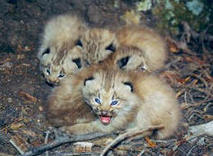Lynx Conservation

Canada lynx (Lynx canadensis) are the most abundant felid species inhabiting North America’s boreal forest. However, southern populations of lynx have declined dramatically in the last century, and in 2000, they were listed as a threatened species by the US Fish and Wildlife Service. While lynx historically extended well into the northern continental US, anthropogenic activities (e.g. trapping, habitat destruction) and climate change have dramatically reduced most US populations.
In response to the declining lynx population, the state of New York attempted to reintroduce lynx in the late 1980's. Eighty-three lynx were released in the Adirondack mountains. Unfortunately, this reintroduction failed - the population never became self-sustaining. It is not exactly clear why this effort was unsuccessful. Because the released lynx were not closely monitored, the fate of many of the lynx is unknown.
In response to the declining lynx population, the state of New York attempted to reintroduce lynx in the late 1980's. Eighty-three lynx were released in the Adirondack mountains. Unfortunately, this reintroduction failed - the population never became self-sustaining. It is not exactly clear why this effort was unsuccessful. Because the released lynx were not closely monitored, the fate of many of the lynx is unknown.

Courtesy of National Geographic
In 1999 the state of Colorado initiated a second lynx reintroduction effort. [See the January 2006 issue of National Geographic for more details.] It had been 26 years since lynx disappeared from Colorado, and now they were on their way back. Unlike the New Yorkreintroduction, the Colorado Division of Wildlife implemented an intensive post-release monitoring program. Biologists monitored where the lynx moved, what they ate, who they interacted with, and causes of mortality. However, for the first 4 years of the project, they could not find any signs of successful breeding. There were no kittens. Critics of the project cited the mortality rate and lack of reproduction as a sign of failure.
However, it is not unusual to have low survival and reproduction during the early stages of a reintroduction effort. Consider the situation: an animal is moved from the wild to captivity, anaesthetized for exams, transported thousands of miles, held in pens near “strangers,” and then released in a completely new environment. It’s not a big surprise that reintroduced animals don’t exhibit typical biological patterns. Biologists have proposed several explanations for what might cause this “reintroduction effect,” but very few studies have actually investigated these theories. Many reintroduction programs fail to monitor the animals after they are released, which has hindered efforts to understand why reproduction and survival are low in the early years of a reintroduction. The value of the Colorado reintroduction lies not only in its contribution to lynx conservation, but also in its contribution to conservation science. Their post-release monitoring will allow us to develop a better understanding of what contributes to the success or failure of a reintroduction effort.
However, it is not unusual to have low survival and reproduction during the early stages of a reintroduction effort. Consider the situation: an animal is moved from the wild to captivity, anaesthetized for exams, transported thousands of miles, held in pens near “strangers,” and then released in a completely new environment. It’s not a big surprise that reintroduced animals don’t exhibit typical biological patterns. Biologists have proposed several explanations for what might cause this “reintroduction effect,” but very few studies have actually investigated these theories. Many reintroduction programs fail to monitor the animals after they are released, which has hindered efforts to understand why reproduction and survival are low in the early years of a reintroduction. The value of the Colorado reintroduction lies not only in its contribution to lynx conservation, but also in its contribution to conservation science. Their post-release monitoring will allow us to develop a better understanding of what contributes to the success or failure of a reintroduction effort.

